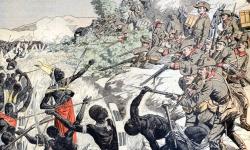
Published date
11 January 1904
Present-day Namibia was once a part of the imperial German empire. As was common during the scramble for Africa in the latter half of the nineteenth century, the territory was claimed and occupied by an expansionist European power, in this case, Germany. Their rule was oppressive and the indigenous cultures were gradually being destroyed. A rebellion by Herero people in Namibia broke out in January 1904 and continued until 31 March 1907. The Herero people had possibly migrated earlier from further north in Africa to settle in Namibia. Their freedom and culture became heavily restricted as German control grew and on 11 January 1904 the leader of the Herero, Samuel Maharero ordered the extermination of all White people excluding the English, Boers, Namas, Basters, Berg-Damaras and missionaries in the German protectorate. There is some contention regarding this order and some researchers believe that the Herero wrote a letter with these instructions after the revolt had already begun.
All preparations for the revolt were kept secret. On 12 January, several hundred mounted Herero invaded Okahandja. They killed 123 people, most of them German, and set buildings alight. The conflict rapidly escalated and Germans who had escaped several farm attacks flocked to urban areas for protection. By 14 January the violence had spread as far as Omarasa, north of the Waterberg, and the Waldau and Waterberg post offices were destroyed. The Waterberg military station was occupied by Herero and all soldiers under the command of Sergeant G. Rademacher were killed.
Maharero, the Herero leader, allowed missionaries with a small number of German women and children free passage to Okahandja. They reached their destination on 9 April 1904. On 16 January Gobabis was besieged and a German military company was ambushed near Otjiwarongo. The conflict continued but eventually, the Herero were overwhelmed. Governor T. Leutwein was prepared to negotiate a settlement, but his government was determined to suppress the revolt with arms. On 11 August the Herero resistance was crushed.
The Herero people were scattered and many of them died of starvation and thirst as they fled through the Omaheke desert. About 12 000 of the remaining Herero were forced to surrender and were placed in concentration camps where medical experiments, as well as daily executions, took place. 80% of the Herero population of Namibia was wiped out during the 1904 revolt. General Von Trotha, a seasoned African campaigner, had been sent to crush the resistance and he ordered that "Within the German borders every Herero, whether armed or unarmed, with or without cattle, will be shot. I shall not accept any more women or children. I shall drive them back to their people - otherwise, I shall order shots to be fired at them". He proceeded to poison watering holes. In a report published in London in 1918, January Cloete of Omaruru stated under oath that, when they defeated the Herero, German soldiers killed unarmed women and children. In 2016, the German government considered making a formal apology to the Herero, but the prospect of cash reparations remains an unlikely outcome.
All preparations for the revolt were kept secret. On 12 January, several hundred mounted Herero invaded Okahandja. They killed 123 people, most of them German, and set buildings alight. The conflict rapidly escalated and Germans who had escaped several farm attacks flocked to urban areas for protection. By 14 January the violence had spread as far as Omarasa, north of the Waterberg, and the Waldau and Waterberg post offices were destroyed. The Waterberg military station was occupied by Herero and all soldiers under the command of Sergeant G. Rademacher were killed.
Maharero, the Herero leader, allowed missionaries with a small number of German women and children free passage to Okahandja. They reached their destination on 9 April 1904. On 16 January Gobabis was besieged and a German military company was ambushed near Otjiwarongo. The conflict continued but eventually, the Herero were overwhelmed. Governor T. Leutwein was prepared to negotiate a settlement, but his government was determined to suppress the revolt with arms. On 11 August the Herero resistance was crushed.
The Herero people were scattered and many of them died of starvation and thirst as they fled through the Omaheke desert. About 12 000 of the remaining Herero were forced to surrender and were placed in concentration camps where medical experiments, as well as daily executions, took place. 80% of the Herero population of Namibia was wiped out during the 1904 revolt. General Von Trotha, a seasoned African campaigner, had been sent to crush the resistance and he ordered that "Within the German borders every Herero, whether armed or unarmed, with or without cattle, will be shot. I shall not accept any more women or children. I shall drive them back to their people - otherwise, I shall order shots to be fired at them". He proceeded to poison watering holes. In a report published in London in 1918, January Cloete of Omaruru stated under oath that, when they defeated the Herero, German soldiers killed unarmed women and children. In 2016, the German government considered making a formal apology to the Herero, but the prospect of cash reparations remains an unlikely outcome.
References
Liebenberg, J. (2004). 'Namibia's dirty little secret revisited'|Wallis, F. (2000). Nuusdagboek: feite en fratse oor 1000 jaar, Kaapstad: Human & Rousseau.|Potgieter, D. J. (ed) (1972). Standard Encyclopaedia of Southern Africa, Vol.5, Cape Town: NASOU, pp. 493-4.|The Sunday Independent, 2 May, 2004.
|
Burke, Jason and Phillip Oltermann (2016). 'Germany moves to atone for 'forgotten Genocide' in Namibia' in the Guardian newspaper, 25th December 2016 and available at https:// https://www.theguardian.com/world/2016/dec/25/germany-moves-to-atone-for-forgotten-genocide-in-namibia (last accessed 11th January 2017).